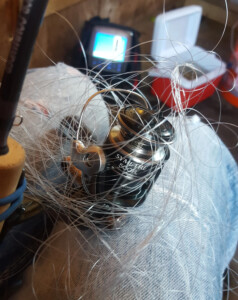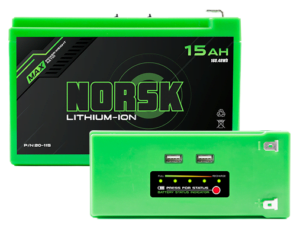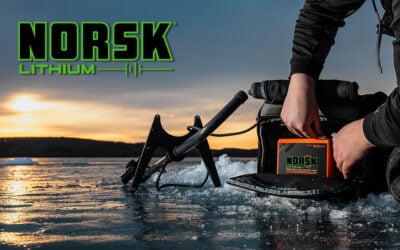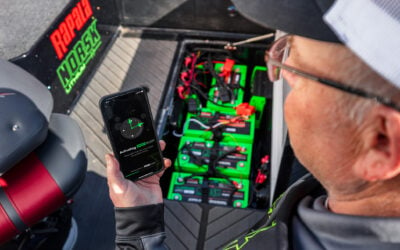Charging Lithium Batteries in Freezing Temperatures
Lithium batteries have revolutionized ice fishing. Charging lithium batteries properly is crucial for you to enjoy the revolution.
It’s a bold statement. We stand behind it. The extreme weight savings offered by lithium batteries have opened the floodgates.
We can leverage new technologies that have been getting all the press over the last couple of years.
If lithium battery power is taken out of the ice sonar equation, there’s no way we would see the industry-wide adoption of Live Imaging and 360 sonar platforms that are bulky in their own right.
Add in the need to power these sonar systems with 20 – 30 pound lead-acid batteries, hand-toted from one ice hole to the next, and the only people that would be using these technologies would be the most diehard ice anglers and NFL lineman looking to stay in shape during the off-season.
Thankfully, lithium batteries are here to stay. The technology built into the premium quality batteries offered by Norsk Lithium continues to push the boundaries of reliability and energy density forward.
Our lithium batteries make the use of larger digital sonar screens combined with Live Imaging or 360 sonar more enjoyable and user-friendly
You can have access to fish-finding tools that your grandpa could have only dreamed of.
But that doesn’t mean just any lithium battery will do. To get the most out of your live imaging or 360 sonar systems, you need a battery that can take a punch from the cold and keep on rolling.
Cheap knock-offs and ancient technology won’t cut it. Norsk Lithium ice batteries upgrade your outdoor experience so you can catch that trophy under the ice that ought to be on your wall.
To get the most out of your ice-fishing electronics, you need to understand how the cold impacts your lithium batteries. Particularly charging lithium batteries.
The Temperature Needed for Charging Lithium Batteries
Before we go any further, we’d like to offer a simple and universal concept regarding lithium batteries.
Lithium batteries can be used to power a device when the internal cell temperature is below 32 degrees with no risk of damage to the battery. This is referred to as a DISCHARGE cycle.
In this article, we address the RECHARGE cycle. That is, putting energy back into the battery to bring it back to full capacity.
No lithium battery should EVER be recharged when the internal cell temperature is below 32 degrees F. Doing so can result in permanent and significant damage to your lithium battery.
Quality batteries, like the batteries offered by Norsk Lithium, have a Battery Management System (BMS) in place that stops our batteries from receiving a charge when the cells are too cold.
Essentially the BMS monitors internal cell temperature and interrupts the charge cycle if the internal cell temperature is too low.
Once the battery is warmed sufficiently then the charge cycle is allowed to take place. This protection that keeps a cold lithium battery from being recharged is critical to any lithium battery that will be used by ice anglers But not all lithium batteries have this feature.
Even if your lithium battery is literally freezing, you can hook it up to a Norsk Lithium charger. The BMS won’t allow the battery to charge until it reaches a safe temperature.
Once the battery warms up above 32 degrees, the charger will kick on, and you’ll be on your way to a fully charged lithium battery.
And a fully powered set of ice-fishing electronics.
The Science Behind Charging Lithium Batteries in the Cold
Charging lithium batteries at freezing temperatures is not possible because of lithium’s chemical composition.
To understand this, you need to know about the science behind the composition and charging of lithium batteries.
You don’t often see the inside of a lithium battery. If you could, this is what you would find, according to The US Department of Energy.
“A battery is made up of an anode, cathode, separator, electrolyte, and two current collectors (positive and negative).

CATHODE CURRENT COLLECTOR (pink) ANODE CURRENT COLLECTOR (blue)
The anode and cathode store the lithium. The electrolyte carries positively charged lithium ions from the anode to the cathode and vice versa through the separator.
The movement of the lithium ions creates free electrons in the anode which creates a charge at the positive current collector.
The electrical current then flows from the current collector through a device being powered (cell phone, computer, etc.) to the negative current collector.”
This bit of science matters because it impacts the chemicals inside a lithium battery that’s being charged or discharged.
When your ice fishing battery is powering your Garmin LiveScope so you can see where Jaws is hiding, energy is being discharged from your battery to your device.
All you did was plug it in. But at a chemical level, inside the battery, the anode releases lithium ions to the cathode. This creates a current of electrons moving from one side of the battery cells to the other.
Those electrodes are then freed to feed your fish finding electronics. The electrons are stored in a current collector and then unleashed to power your gear.
Lithium is remarkably potent, efficient, and durable. It can handle the cold better than most people.
But when charging lithium batteries, it’s a different story. Chemically, the process is reversed. Lithium ions are released from the cathode and then move to the anode.
If this happens at below-freezing temperatures, a chemical reaction called “lithium plating” occurs.
The engineers at Purdue University explain it like this:
“lithium ions start to accumulate on the surface of the anode… growing metallic deposits, which restrict the transport of further ions.”
When this plating happens, it severely and irreversibly damages the lithium battery.
Think of it like getting a rat’s nest in your fishing reel. You limit the use of your line at the point of the knot. And if you don’t untangle it or cut it off, the knot will only grow. Eventually, the whole line will be shot.

This is the kind of thing that happens with lithium plating. Except, you can’t untangle this knot. The damage is irreversible.
Charging lithium batteries in the cold irreversibly damages the chemistry inside the battery. That’s why every Norsk Lithium battery is engineered with a BMS that offers protection against accidentally charging your battery when it is too cold.
Charging Lithium Batteries with the Norsk Advantage
We understand that your investment in lithium batteries is about more than money. It’s about reliability. You spent your hard-earned cash on lithium batteries to maximize your time outdoors.
We have all wasted too much time wondering if our old, heavy, inefficient lead-acid batteries will be able to get the job done.
There was no way of knowing how much juice the battery had left until you got out on the ice. And by then, it was too late.
We’re done playing that game.
You should be too.
 Norsk Lithium batteries not only have a BMS to protect the internal integrity of your lithium battery but also an LED power indicator so you can check your battery’s level of charge with the push of a button.
Norsk Lithium batteries not only have a BMS to protect the internal integrity of your lithium battery but also an LED power indicator so you can check your battery’s level of charge with the push of a button.
You won’t have to guess how much juice your battery has. Or how long it will run.
Our team is relentlessly pushing the boundaries of modern technology. We want to get everything we can out of lithium power so we can get everything we can out of a day on the ice!
Beyond all of this, we’ve also included patent-pending dual USB ports in all of our batteries. Not only can you charge your fish-finders, but you can also charge your phone, bait aerators, shanty lights, or basically anything that can be charged with a USB port.
Our engineers have gone the extra mile to develop the ideal chargers for charging lithium batteries.
The most common customer service issue we receive is from people who do not use the correct charger.
Norsk Lithium chargers are designed to work with the chemistry inside our lithium batteries to ensure optimal charging, efficiency, and long-term health of your battery.
Getting your gear ready for a day on the ice should be fun. Checking and charging your battery should give you confidence, not anxiety.
With Norsk Lithium’s full assortment of supplies, you can power your passion.
How to Properly Charge Lithium Batteries in the Cold
As we’ve seen, you can’t charge lithium batteries in the cold. You must wait for them to warm up or risk irreversible damage caused by lithium plating.
We recommend that you let your lithium batteries warm up naturally. Please don’t put them on or near a direct heating source like a wood stove, furnace, or space heater.
Let your lithium battery’s internal temperature gradually rise by simply being indoors at room temperature.
Remember, the internal temperature of the lithium battery only needs to return to 32 degrees. In the vast majority of cases, that won’t take long.
You can check out this article for a comprehensive explanation of how to properly charge a lithium battery.
Here, we’ll just hit the high points.
– Plug your Norsk Lithium Charger into an outlet
– Hook up your Norsk Lithium battery to the charging harness that is included with all Norsk Lithium chargers
– Make sure that the red wire “plus” is connected to the “plus / positive” terminal on the battery and the black wire “negative” is connected to the “minus / negative” terminal on the battery.
– Walk away and enjoy your evening! When the red light on the charger turns to green, the recharge cycle is complete, and your battery is fully recharged.
Be aware that if you do not hook up the battery correctly, it won’t charge. Due to our BMS that protects the battery from reverse polarity connections being made, you won’t damage the battery because it won’t be allowed to receive a charge.
The BMS is your battery’s best friend. You can hook up your ice fishing battery to the charger as soon as you get inside. Your lithium battery will be protected. The charger won’t kick on until it’s safe for your battery.
The BMS will also protect you from overcharging your lithium battery. Once the battery is “full,” the BMS will block any further activity.
Power Your Passion with Norsk Lithium
We personally understand how much effort is required to get the most out of a day on the ice. We strive to create the best lithium batteries because we want to have the best outdoor experience.
Second rate, b-level quality has no place here.
Your time is too valuable to be squandered by inefficient and unreliable batteries.
Properly charging lithium batteries in the cold is just one piece of a bigger puzzle for you to fully enjoy ice-fishing.
We’re here to answer any further questions you may have. Just reach out! We want to hear from you.
Lithium batteries have forever changed the game. Don’t miss out. The best bites are waiting for you under the ice.
Norsk Lithium powers your passion. Get out there and chase your adventure!





0 Comments